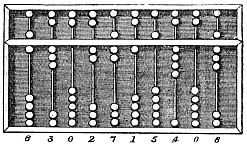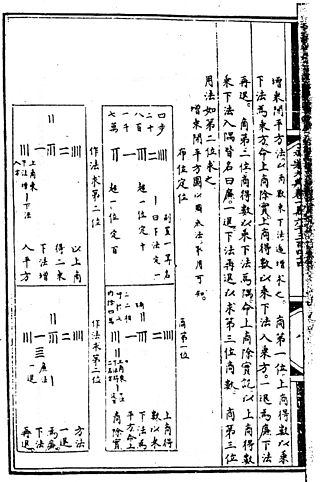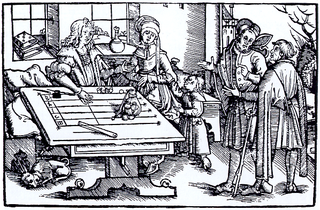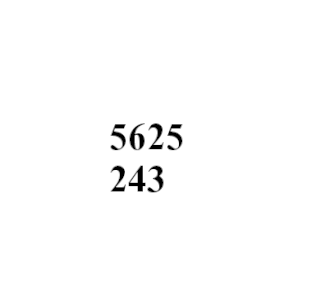
An abacus, also called a counting frame, is a hand-operated calculating tool which was used from ancient times in the ancient Near East, Europe, China, and Russia, until the adoption of the Hindu-Arabic numeral system. An abacus consists of a two-dimensional array of slidable beads. In their earliest designs, the beads could be loose on a flat surface or sliding in grooves. Later the beads were made to slide on rods and built into a frame, allowing faster manipulation.

In mathematics and computer science, an algorithm is a finite sequence of rigorous instructions, typically used to solve a class of specific problems or to perform a computation. Algorithms are used as specifications for performing calculations and data processing. More advanced algorithms can use conditionals to divert the code execution through various routes and deduce valid inferences, achieving automation eventually. Using human characteristics as descriptors of machines in metaphorical ways was already practiced by Alan Turing with terms such as "memory", "search" and "stimulus".

Arithmetic is an elementary branch of mathematics that studies numerical operations like addition, subtraction, multiplication, and division. In a wider sense, it also includes exponentiation, extraction of roots, and taking logarithms. Arithmetic systems can be distinguished based on the type of number they operate on. Integer arithmetic restricts itself to calculations with positive and negative whole numbers. Rational number arithmetic involves operations on fractions that lie between integers. Real number arithmetic includes calculations with both rational and irrational numbers and covers the complete number line. Another distinction is based on the numeral system employed to perform calculations. Decimal arithmetic is the most common. It uses the basic numerals from 0 to 9 and their combinations to express numbers. Binary arithmetic, by contrast, is used by most computers and represents numbers as combinations of the basic numerals 0 and 1. Some arithmetic systems operate on mathematical objects other than numbers, such as interval arithmetic and matrix arithmetic.
Calculus is the mathematical study of continuous change, in the same way that geometry is the study of shape, and algebra is the study of generalizations of arithmetic operations.
A computation is any type of arithmetic or non-arithmetic calculation that is well-defined. Common examples of computations are mathematical equations and computer algorithms.

The history of mathematics deals with the origin of discoveries in mathematics and the mathematical methods and notation of the past. Before the modern age and the worldwide spread of knowledge, written examples of new mathematical developments have come to light only in a few locales. From 3000 BC the Mesopotamian states of Sumer, Akkad and Assyria, followed closely by Ancient Egypt and the Levantine state of Ebla began using arithmetic, algebra and geometry for purposes of taxation, commerce, trade and also in the patterns in nature, the field of astronomy and to record time and formulate calendars.
In ordinary language, an average is a single number or value that best represents a set of data. The type of average taken as most typically representative of a list of numbers is the arithmetic mean – the sum of the numbers divided by how many numbers are in the list. For example, the mean average of the numbers 2, 3, 4, 7, and 9 is 5. Depending on the context, the most representative statistic to be taken as the average might be another measure of central tendency, such as the mid-range, median, mode or geometric mean. For example, the average personal income is often given as the median – the number below which are 50% of personal incomes and above which are 50% of personal incomes – because the mean would be higher by including personal incomes from a few billionaires. For this reason, it is recommended to avoid using the word "average" when discussing measures of central tendency and specify which type of measure of average is being used.

Liber Abaci is a historic 1202 Latin manuscript on arithmetic by Leonardo of Pisa, posthumously known as Fibonacci.

Algorism is the technique of performing basic arithmetic by writing numbers in place value form and applying a set of memorized rules and facts to the digits. One who practices algorism is known as an algorist. This positional notation system has largely superseded earlier calculation systems that used a different set of symbols for each numerical magnitude, such as Roman numerals, and in some cases required a device such as an abacus.
Calculus, originally called infinitesimal calculus, is a mathematical discipline focused on limits, continuity, derivatives, integrals, and infinite series. Many elements of calculus appeared in ancient Greece, then in China and the Middle East, and still later again in medieval Europe and in India. Infinitesimal calculus was developed in the late 17th century by Isaac Newton and Gottfried Wilhelm Leibniz independently of each other. An argument over priority led to the Leibniz–Newton calculus controversy which continued until the death of Leibniz in 1716. The development of calculus and its uses within the sciences have continued to the present day.

The suanpan, also spelled suan pan or souanpan) is an abacus of Chinese origin first described in a 190 CE book of the Eastern Han Dynasty, namely Supplementary Notes on the Art of Figures written by Xu Yue. However, the exact design of this suanpan is not known. Usually, a suanpan is about 20 cm (8 in) tall and it comes in various widths depending on the application. It usually has more than seven rods. There are two beads on each rod in the upper deck and five beads on each rod in the bottom deck. The beads are usually rounded and made of a hardwood. The beads are counted by moving them up or down towards the beam. The suanpan can be reset to the starting position instantly by a quick jerk around the horizontal axis to spin all the beads away from the horizontal beam at the center.

Mathematics emerged independently in China by the 11th century BCE. The Chinese independently developed a real number system that includes significantly large and negative numbers, more than one numeral system, algebra, geometry, number theory and trigonometry.
Lattice multiplication, also known as the Italian method, Chinese method, Chinese lattice, gelosia multiplication, sieve multiplication, shabakh, diagonally or Venetian squares, is a method of multiplication that uses a lattice to multiply two multi-digit numbers. It is mathematically identical to the more commonly used long multiplication algorithm, but it breaks the process into smaller steps, which some practitioners find easier to use.

Rod calculus or rod calculation was the mechanical method of algorithmic computation with counting rods in China from the Warring States to Ming dynasty before the counting rods were increasingly replaced by the more convenient and faster abacus. Rod calculus played a key role in the development of Chinese mathematics to its height in Song Dynasty and Yuan Dynasty, culminating in the invention of polynomial equations of up to four unknowns in the work of Zhu Shijie.

The counting board is the precursor of the abacus, and the earliest known form of a counting device. Counting boards were made of stone or wood, and the counting was done on the board with beads, pebbles etc. Not many boards survive because of the perishable materials used in their construction, or the impossibility to identify the object as a counting board.The counting board was invented to facilitate and streamline numerical calculations in ancient civilizations. Its inception addressed the need for a practical tool to perform arithmetic operations efficiently. By using counters or tokens on a board with designated sections, people could easily keep track of quantities, trade, and financial transactions. This invention not only enhanced accuracy but also fueled the development of more sophisticated mathematical concepts and systems throughout history.
A timeline of numerals and arithmetic.
This is a timeline of pure and applied mathematics history. It is divided here into three stages, corresponding to stages in the development of mathematical notation: a "rhetorical" stage in which calculations are described purely by words, a "syncopated" stage in which quantities and common algebraic operations are beginning to be represented by symbolic abbreviations, and finally a "symbolic" stage, in which comprehensive notational systems for formulas are the norm.

Principles of Hindu Reckoning is a mathematics book written by the 10th- and 11th-century Persian mathematician Kushyar ibn Labban. It is the second-oldest book extant in Arabic about Hindu arithmetic using Hindu-Arabic numerals, preceded by Kibab al-Fusul fi al-Hisub al-Hindi by Abul al-Hassan Ahmad ibn Ibrahim al-Uglidis, written in 952.

The Salamis Tablet is a marble counting board dating from around 300 BC, that was discovered on the island of Salamis in 1846. A precursor to the abacus, it is thought that it represents an ancient Greek means of performing mathematical calculations common in the ancient world. Pebbles were placed at various locations and could be moved as calculations were performed. The marble tablet itself has dimensions of approximately 150 × 75 × 4.5 cm.

Zhusuan is the knowledge and practices of arithmetic calculation through the suanpan or Chinese abacus. In the year 2013, it has been inscribed on the UNESCO Representative List of the Intangible Cultural Heritage of Humanity. While deciding on the inscription, the Intergovernmental Committee noted that "Zhusuan is considered by Chinese people as a cultural symbol of their identity as well as a practical tool; transmitted from generation to generation, it is a calculating technique adapted to multiple aspects of daily life, serving multiform socio-cultural functions and offering the world an alternative knowledge system." The movement to get Chinese Zhusuan inscribed in the list was spearheaded by Chinese Abacus and Mental Arithmetic Association.


























